Population Health Project Plan 1 for South Australian Dental
VerifiedAdded on 2023/06/18
|12
|2535
|423
AI Summary
This project will explore the oral health among homeless people as the priority population. The project will increase oral health literacy of homeless people. The strategies in this project will build the individuals’ capacities and help them make better decisions about their health.
Contribute Materials
Your contribution can guide someone’s learning journey. Share your
documents today.
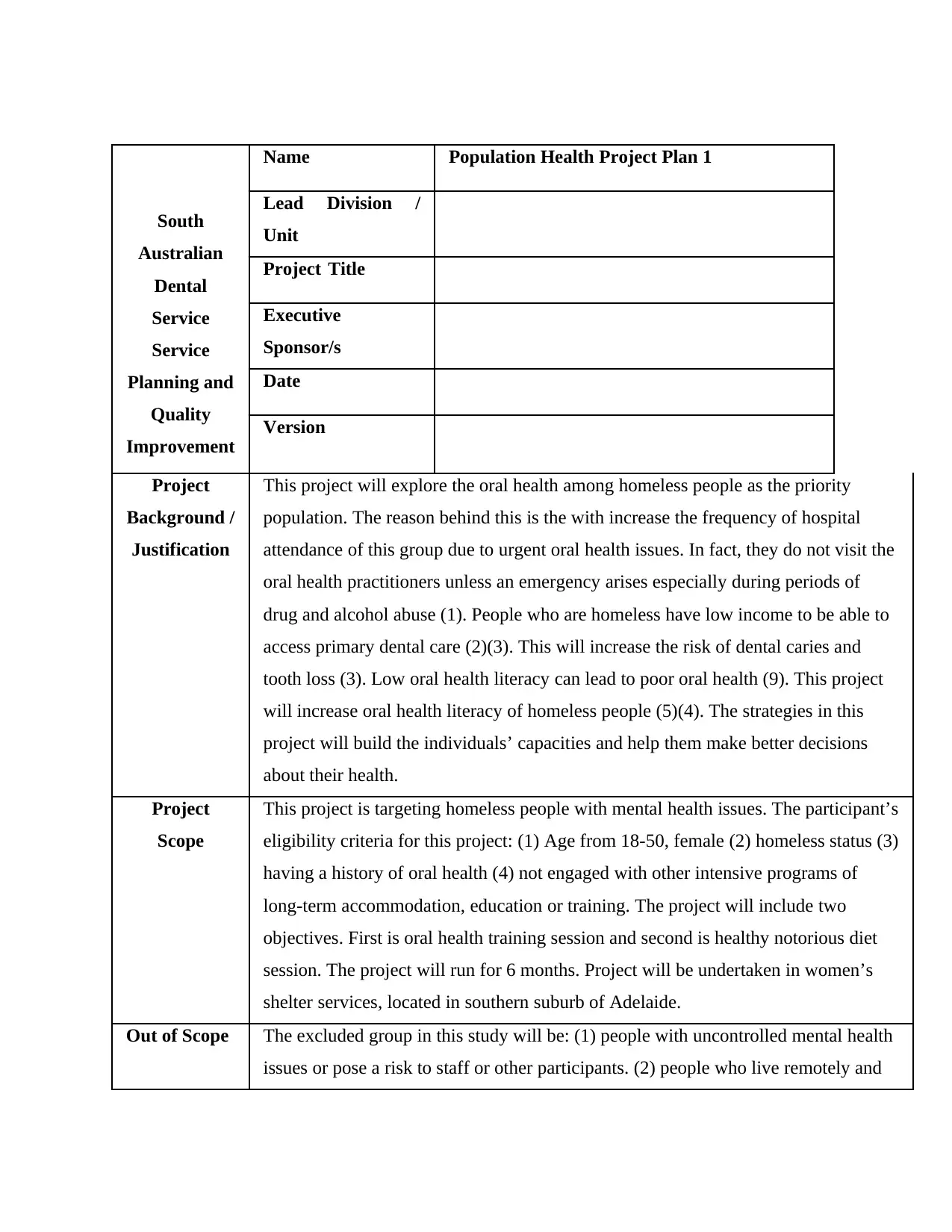
South
Australian
Dental
Service
Service
Planning and
Quality
Improvement
Name Population Health Project Plan 1
Lead Division /
Unit
Project Title
Executive
Sponsor/s
Date
Version
Project
Background /
Justification
This project will explore the oral health among homeless people as the priority
population. The reason behind this is the with increase the frequency of hospital
attendance of this group due to urgent oral health issues. In fact, they do not visit the
oral health practitioners unless an emergency arises especially during periods of
drug and alcohol abuse (1). People who are homeless have low income to be able to
access primary dental care (2)(3). This will increase the risk of dental caries and
tooth loss (3). Low oral health literacy can lead to poor oral health (9). This project
will increase oral health literacy of homeless people (5)(4). The strategies in this
project will build the individuals’ capacities and help them make better decisions
about their health.
Project
Scope
This project is targeting homeless people with mental health issues. The participant’s
eligibility criteria for this project: (1) Age from 18-50, female (2) homeless status (3)
having a history of oral health (4) not engaged with other intensive programs of
long-term accommodation, education or training. The project will include two
objectives. First is oral health training session and second is healthy notorious diet
session. The project will run for 6 months. Project will be undertaken in women’s
shelter services, located in southern suburb of Adelaide.
Out of Scope The excluded group in this study will be: (1) people with uncontrolled mental health
issues or pose a risk to staff or other participants. (2) people who live remotely and
Australian
Dental
Service
Service
Planning and
Quality
Improvement
Name Population Health Project Plan 1
Lead Division /
Unit
Project Title
Executive
Sponsor/s
Date
Version
Project
Background /
Justification
This project will explore the oral health among homeless people as the priority
population. The reason behind this is the with increase the frequency of hospital
attendance of this group due to urgent oral health issues. In fact, they do not visit the
oral health practitioners unless an emergency arises especially during periods of
drug and alcohol abuse (1). People who are homeless have low income to be able to
access primary dental care (2)(3). This will increase the risk of dental caries and
tooth loss (3). Low oral health literacy can lead to poor oral health (9). This project
will increase oral health literacy of homeless people (5)(4). The strategies in this
project will build the individuals’ capacities and help them make better decisions
about their health.
Project
Scope
This project is targeting homeless people with mental health issues. The participant’s
eligibility criteria for this project: (1) Age from 18-50, female (2) homeless status (3)
having a history of oral health (4) not engaged with other intensive programs of
long-term accommodation, education or training. The project will include two
objectives. First is oral health training session and second is healthy notorious diet
session. The project will run for 6 months. Project will be undertaken in women’s
shelter services, located in southern suburb of Adelaide.
Out of Scope The excluded group in this study will be: (1) people with uncontrolled mental health
issues or pose a risk to staff or other participants. (2) people who live remotely and
Secure Best Marks with AI Grader
Need help grading? Try our AI Grader for instant feedback on your assignments.
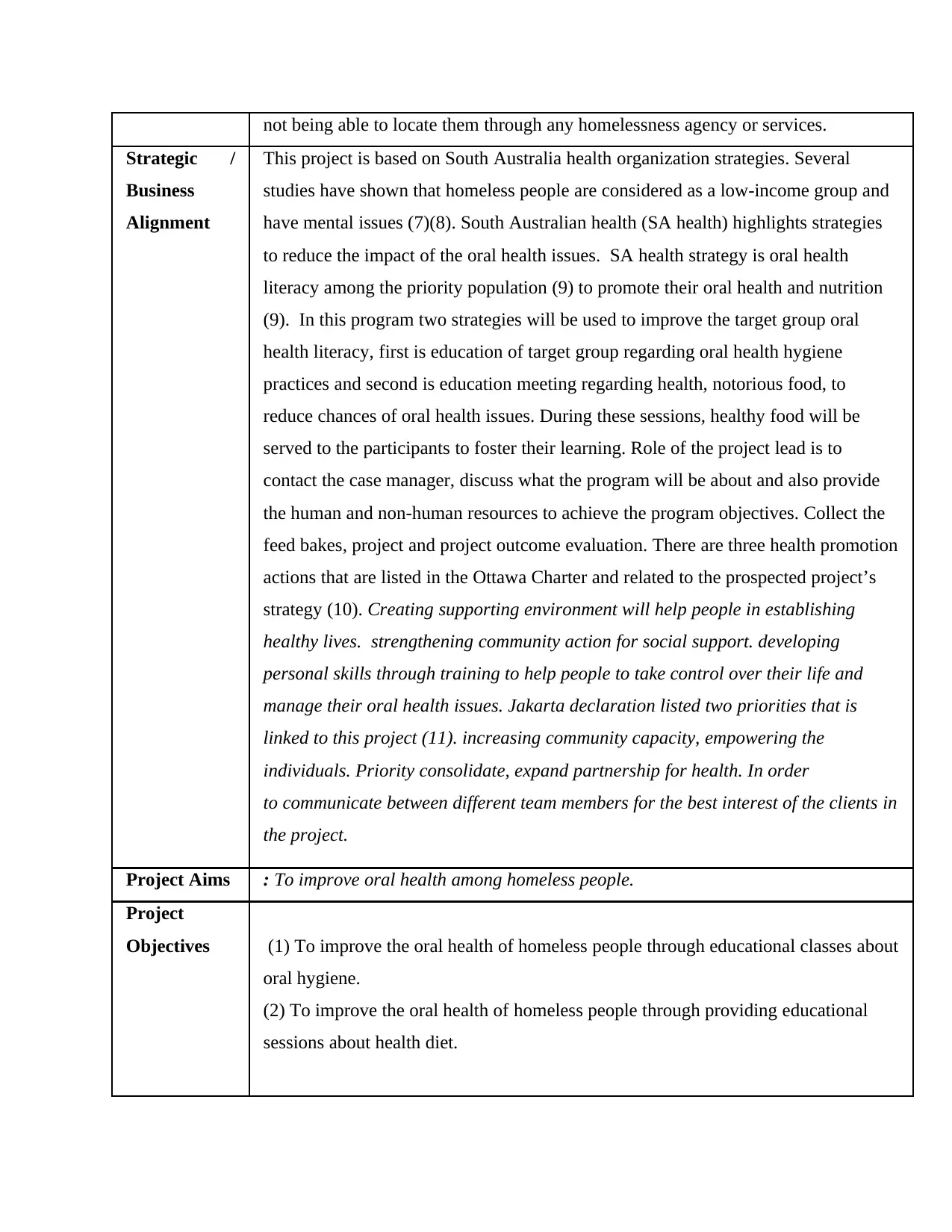
not being able to locate them through any homelessness agency or services.
Strategic /
Business
Alignment
This project is based on South Australia health organization strategies. Several
studies have shown that homeless people are considered as a low-income group and
have mental issues (7)(8). South Australian health (SA health) highlights strategies
to reduce the impact of the oral health issues. SA health strategy is oral health
literacy among the priority population (9) to promote their oral health and nutrition
(9). In this program two strategies will be used to improve the target group oral
health literacy, first is education of target group regarding oral health hygiene
practices and second is education meeting regarding health, notorious food, to
reduce chances of oral health issues. During these sessions, healthy food will be
served to the participants to foster their learning. Role of the project lead is to
contact the case manager, discuss what the program will be about and also provide
the human and non-human resources to achieve the program objectives. Collect the
feed bakes, project and project outcome evaluation. There are three health promotion
actions that are listed in the Ottawa Charter and related to the prospected project’s
strategy (10). Creating supporting environment will help people in establishing
healthy lives. strengthening community action for social support. developing
personal skills through training to help people to take control over their life and
manage their oral health issues. Jakarta declaration listed two priorities that is
linked to this project (11). increasing community capacity, empowering the
individuals. Priority consolidate, expand partnership for health. In order
to communicate between different team members for the best interest of the clients in
the project.
Project Aims : To improve oral health among homeless people.
Project
Objectives (1) To improve the oral health of homeless people through educational classes about
oral hygiene.
(2) To improve the oral health of homeless people through providing educational
sessions about health diet.
Strategic /
Business
Alignment
This project is based on South Australia health organization strategies. Several
studies have shown that homeless people are considered as a low-income group and
have mental issues (7)(8). South Australian health (SA health) highlights strategies
to reduce the impact of the oral health issues. SA health strategy is oral health
literacy among the priority population (9) to promote their oral health and nutrition
(9). In this program two strategies will be used to improve the target group oral
health literacy, first is education of target group regarding oral health hygiene
practices and second is education meeting regarding health, notorious food, to
reduce chances of oral health issues. During these sessions, healthy food will be
served to the participants to foster their learning. Role of the project lead is to
contact the case manager, discuss what the program will be about and also provide
the human and non-human resources to achieve the program objectives. Collect the
feed bakes, project and project outcome evaluation. There are three health promotion
actions that are listed in the Ottawa Charter and related to the prospected project’s
strategy (10). Creating supporting environment will help people in establishing
healthy lives. strengthening community action for social support. developing
personal skills through training to help people to take control over their life and
manage their oral health issues. Jakarta declaration listed two priorities that is
linked to this project (11). increasing community capacity, empowering the
individuals. Priority consolidate, expand partnership for health. In order
to communicate between different team members for the best interest of the clients in
the project.
Project Aims : To improve oral health among homeless people.
Project
Objectives (1) To improve the oral health of homeless people through educational classes about
oral hygiene.
(2) To improve the oral health of homeless people through providing educational
sessions about health diet.
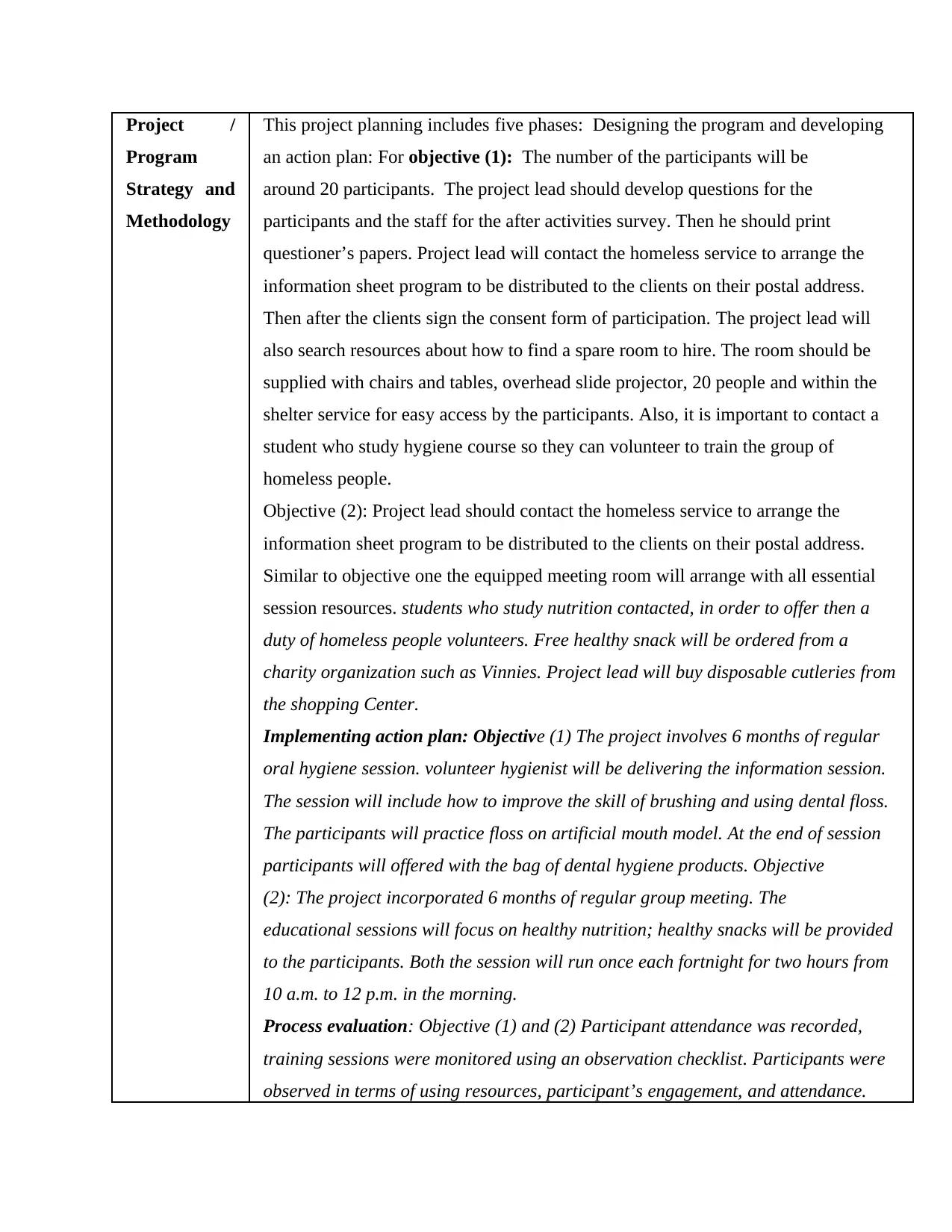
Project /
Program
Strategy and
Methodology
This project planning includes five phases: Designing the program and developing
an action plan: For objective (1): The number of the participants will be
around 20 participants. The project lead should develop questions for the
participants and the staff for the after activities survey. Then he should print
questioner’s papers. Project lead will contact the homeless service to arrange the
information sheet program to be distributed to the clients on their postal address.
Then after the clients sign the consent form of participation. The project lead will
also search resources about how to find a spare room to hire. The room should be
supplied with chairs and tables, overhead slide projector, 20 people and within the
shelter service for easy access by the participants. Also, it is important to contact a
student who study hygiene course so they can volunteer to train the group of
homeless people.
Objective (2): Project lead should contact the homeless service to arrange the
information sheet program to be distributed to the clients on their postal address.
Similar to objective one the equipped meeting room will arrange with all essential
session resources. students who study nutrition contacted, in order to offer then a
duty of homeless people volunteers. Free healthy snack will be ordered from a
charity organization such as Vinnies. Project lead will buy disposable cutleries from
the shopping Center.
Implementing action plan: Objective (1) The project involves 6 months of regular
oral hygiene session. volunteer hygienist will be delivering the information session.
The session will include how to improve the skill of brushing and using dental floss.
The participants will practice floss on artificial mouth model. At the end of session
participants will offered with the bag of dental hygiene products. Objective
(2): The project incorporated 6 months of regular group meeting. The
educational sessions will focus on healthy nutrition; healthy snacks will be provided
to the participants. Both the session will run once each fortnight for two hours from
10 a.m. to 12 p.m. in the morning.
Process evaluation: Objective (1) and (2) Participant attendance was recorded,
training sessions were monitored using an observation checklist. Participants were
observed in terms of using resources, participant’s engagement, and attendance.
Program
Strategy and
Methodology
This project planning includes five phases: Designing the program and developing
an action plan: For objective (1): The number of the participants will be
around 20 participants. The project lead should develop questions for the
participants and the staff for the after activities survey. Then he should print
questioner’s papers. Project lead will contact the homeless service to arrange the
information sheet program to be distributed to the clients on their postal address.
Then after the clients sign the consent form of participation. The project lead will
also search resources about how to find a spare room to hire. The room should be
supplied with chairs and tables, overhead slide projector, 20 people and within the
shelter service for easy access by the participants. Also, it is important to contact a
student who study hygiene course so they can volunteer to train the group of
homeless people.
Objective (2): Project lead should contact the homeless service to arrange the
information sheet program to be distributed to the clients on their postal address.
Similar to objective one the equipped meeting room will arrange with all essential
session resources. students who study nutrition contacted, in order to offer then a
duty of homeless people volunteers. Free healthy snack will be ordered from a
charity organization such as Vinnies. Project lead will buy disposable cutleries from
the shopping Center.
Implementing action plan: Objective (1) The project involves 6 months of regular
oral hygiene session. volunteer hygienist will be delivering the information session.
The session will include how to improve the skill of brushing and using dental floss.
The participants will practice floss on artificial mouth model. At the end of session
participants will offered with the bag of dental hygiene products. Objective
(2): The project incorporated 6 months of regular group meeting. The
educational sessions will focus on healthy nutrition; healthy snacks will be provided
to the participants. Both the session will run once each fortnight for two hours from
10 a.m. to 12 p.m. in the morning.
Process evaluation: Objective (1) and (2) Participant attendance was recorded,
training sessions were monitored using an observation checklist. Participants were
observed in terms of using resources, participant’s engagement, and attendance.
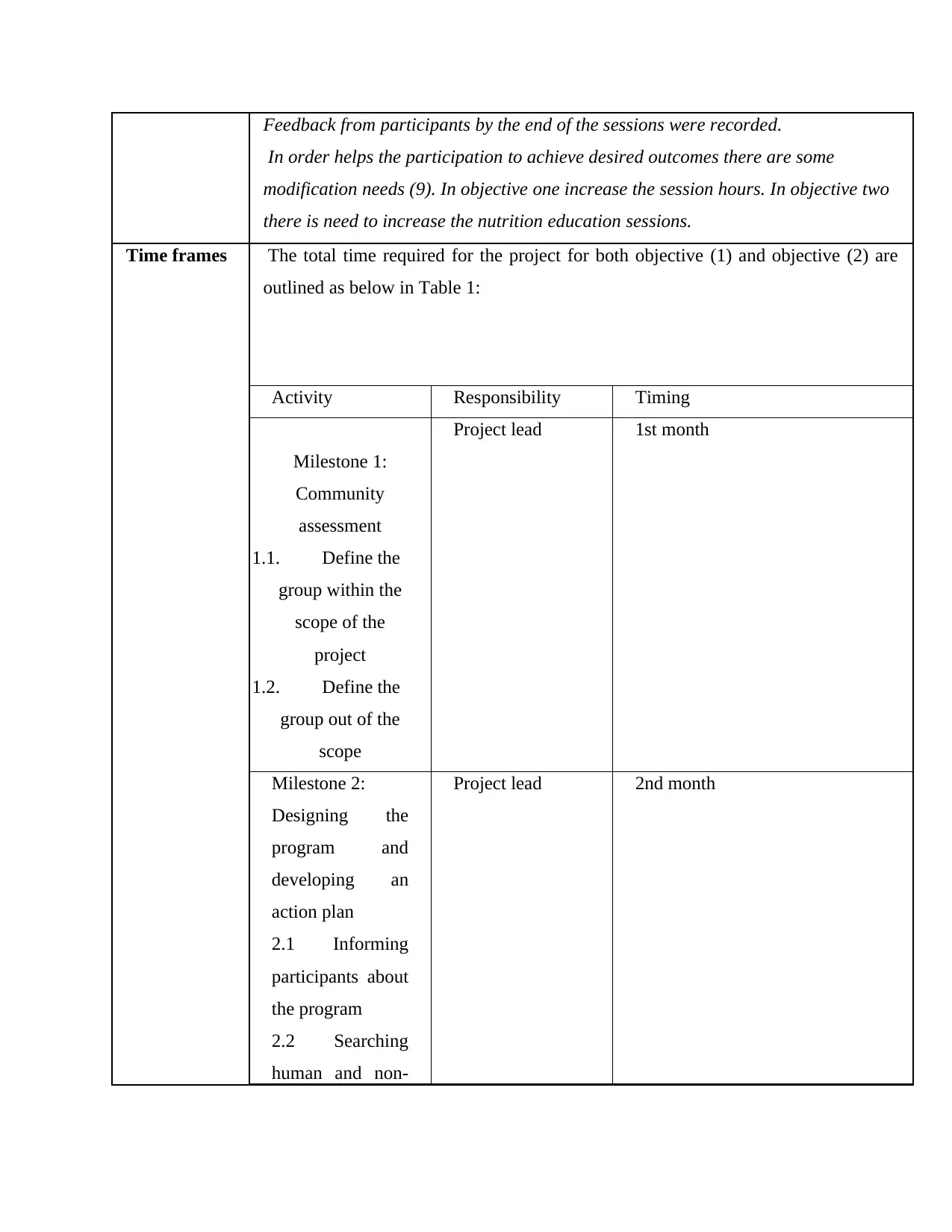
Feedback from participants by the end of the sessions were recorded.
In order helps the participation to achieve desired outcomes there are some
modification needs (9). In objective one increase the session hours. In objective two
there is need to increase the nutrition education sessions.
Time frames The total time required for the project for both objective (1) and objective (2) are
outlined as below in Table 1:
Activity Responsibility Timing
Milestone 1:
Community
assessment
1.1. Define the
group within the
scope of the
project
1.2. Define the
group out of the
scope
Project lead 1st month
Milestone 2:
Designing the
program and
developing an
action plan
2.1 Informing
participants about
the program
2.2 Searching
human and non-
Project lead 2nd month
In order helps the participation to achieve desired outcomes there are some
modification needs (9). In objective one increase the session hours. In objective two
there is need to increase the nutrition education sessions.
Time frames The total time required for the project for both objective (1) and objective (2) are
outlined as below in Table 1:
Activity Responsibility Timing
Milestone 1:
Community
assessment
1.1. Define the
group within the
scope of the
project
1.2. Define the
group out of the
scope
Project lead 1st month
Milestone 2:
Designing the
program and
developing an
action plan
2.1 Informing
participants about
the program
2.2 Searching
human and non-
Project lead 2nd month
Secure Best Marks with AI Grader
Need help grading? Try our AI Grader for instant feedback on your assignments.
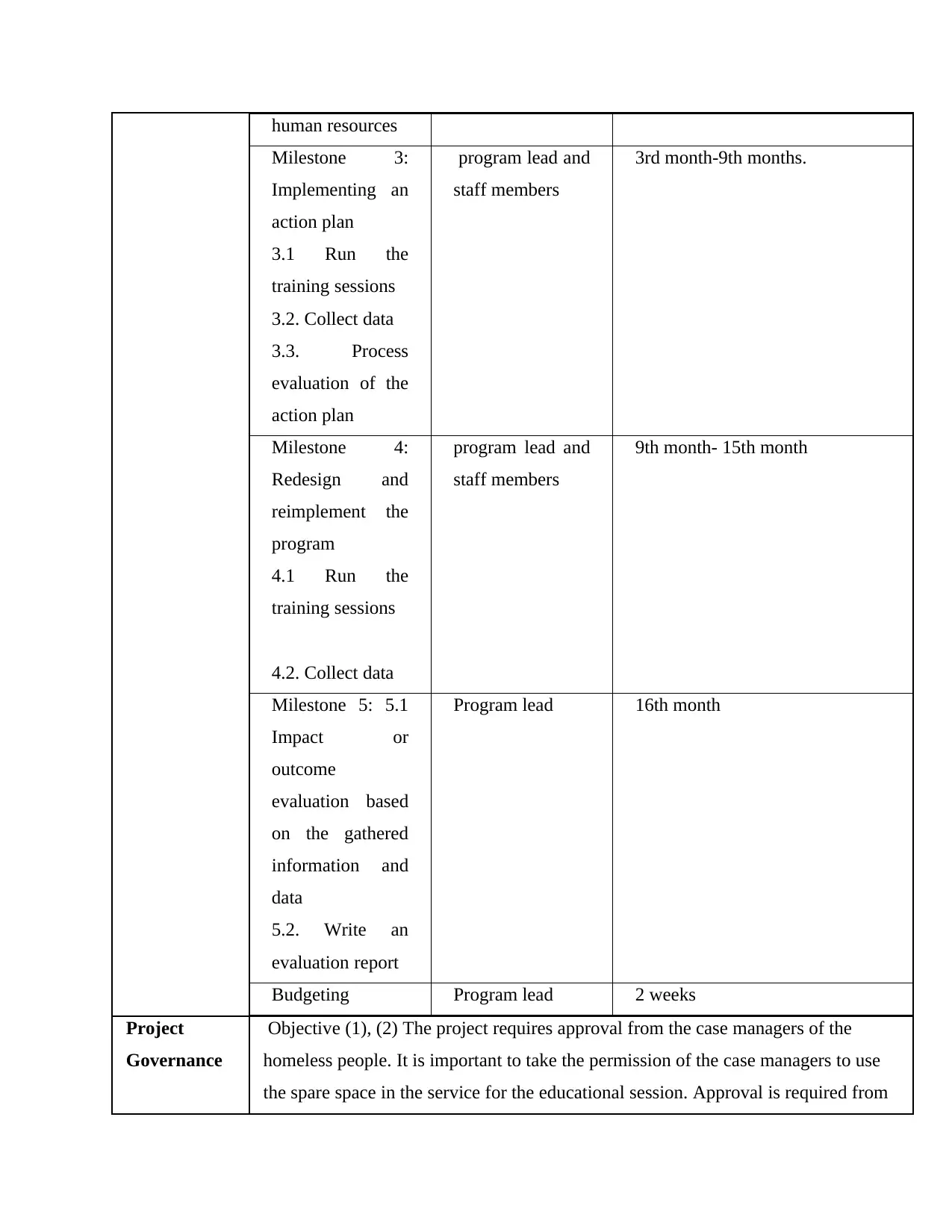
human resources
Milestone 3:
Implementing an
action plan
3.1 Run the
training sessions
3.2. Collect data
3.3. Process
evaluation of the
action plan
program lead and
staff members
3rd month-9th months.
Milestone 4:
Redesign and
reimplement the
program
4.1 Run the
training sessions
4.2. Collect data
program lead and
staff members
9th month- 15th month
Milestone 5: 5.1
Impact or
outcome
evaluation based
on the gathered
information and
data
5.2. Write an
evaluation report
Program lead 16th month
Budgeting Program lead 2 weeks
Project
Governance
Objective (1), (2) The project requires approval from the case managers of the
homeless people. It is important to take the permission of the case managers to use
the spare space in the service for the educational session. Approval is required from
Milestone 3:
Implementing an
action plan
3.1 Run the
training sessions
3.2. Collect data
3.3. Process
evaluation of the
action plan
program lead and
staff members
3rd month-9th months.
Milestone 4:
Redesign and
reimplement the
program
4.1 Run the
training sessions
4.2. Collect data
program lead and
staff members
9th month- 15th month
Milestone 5: 5.1
Impact or
outcome
evaluation based
on the gathered
information and
data
5.2. Write an
evaluation report
Program lead 16th month
Budgeting Program lead 2 weeks
Project
Governance
Objective (1), (2) The project requires approval from the case managers of the
homeless people. It is important to take the permission of the case managers to use
the spare space in the service for the educational session. Approval is required from
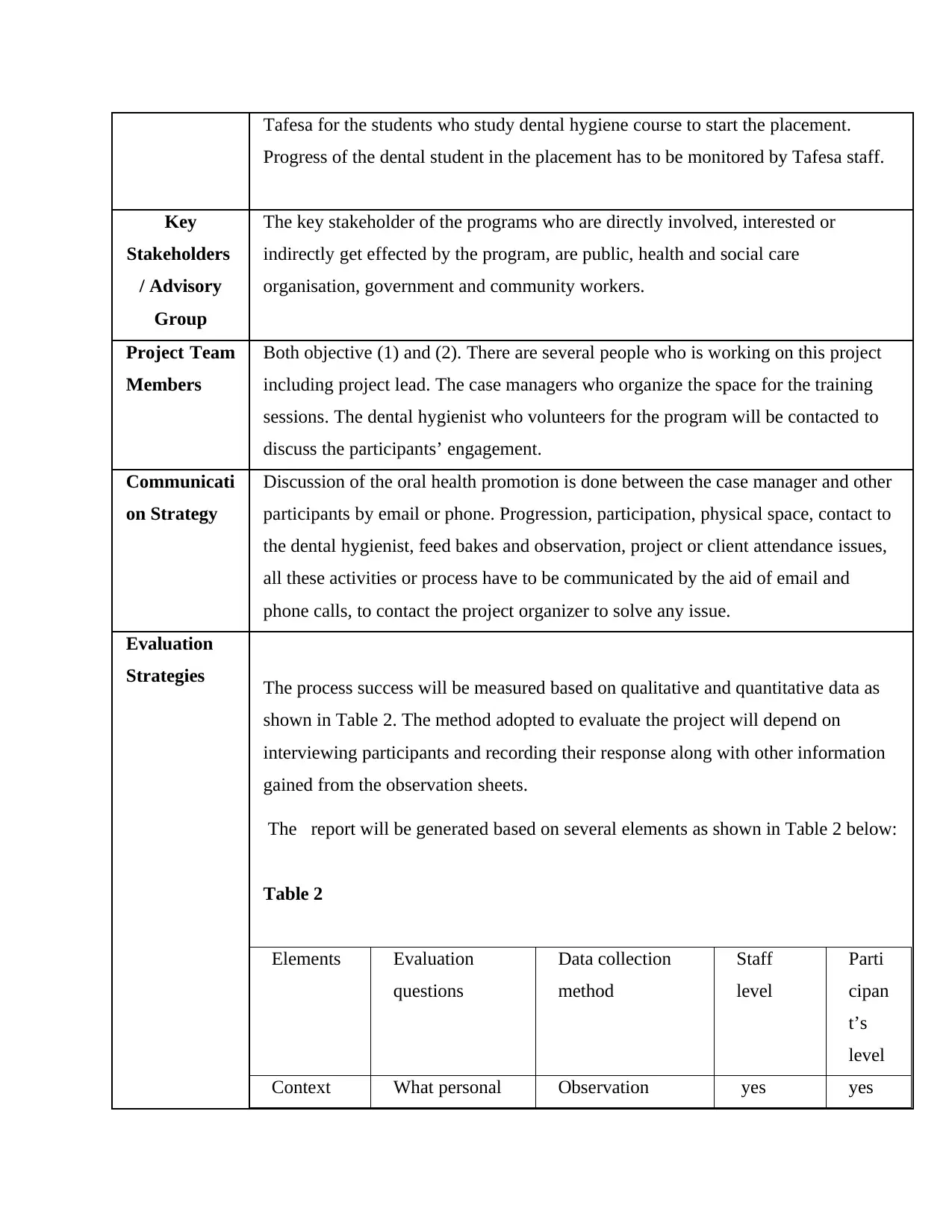
Tafesa for the students who study dental hygiene course to start the placement.
Progress of the dental student in the placement has to be monitored by Tafesa staff.
Key
Stakeholders
/ Advisory
Group
The key stakeholder of the programs who are directly involved, interested or
indirectly get effected by the program, are public, health and social care
organisation, government and community workers.
Project Team
Members
Both objective (1) and (2). There are several people who is working on this project
including project lead. The case managers who organize the space for the training
sessions. The dental hygienist who volunteers for the program will be contacted to
discuss the participants’ engagement.
Communicati
on Strategy
Discussion of the oral health promotion is done between the case manager and other
participants by email or phone. Progression, participation, physical space, contact to
the dental hygienist, feed bakes and observation, project or client attendance issues,
all these activities or process have to be communicated by the aid of email and
phone calls, to contact the project organizer to solve any issue.
Evaluation
Strategies The process success will be measured based on qualitative and quantitative data as
shown in Table 2. The method adopted to evaluate the project will depend on
interviewing participants and recording their response along with other information
gained from the observation sheets.
The report will be generated based on several elements as shown in Table 2 below:
Table 2
Elements Evaluation
questions
Data collection
method
Staff
level
Parti
cipan
t’s
level
Context What personal Observation yes yes
Progress of the dental student in the placement has to be monitored by Tafesa staff.
Key
Stakeholders
/ Advisory
Group
The key stakeholder of the programs who are directly involved, interested or
indirectly get effected by the program, are public, health and social care
organisation, government and community workers.
Project Team
Members
Both objective (1) and (2). There are several people who is working on this project
including project lead. The case managers who organize the space for the training
sessions. The dental hygienist who volunteers for the program will be contacted to
discuss the participants’ engagement.
Communicati
on Strategy
Discussion of the oral health promotion is done between the case manager and other
participants by email or phone. Progression, participation, physical space, contact to
the dental hygienist, feed bakes and observation, project or client attendance issues,
all these activities or process have to be communicated by the aid of email and
phone calls, to contact the project organizer to solve any issue.
Evaluation
Strategies The process success will be measured based on qualitative and quantitative data as
shown in Table 2. The method adopted to evaluate the project will depend on
interviewing participants and recording their response along with other information
gained from the observation sheets.
The report will be generated based on several elements as shown in Table 2 below:
Table 2
Elements Evaluation
questions
Data collection
method
Staff
level
Parti
cipan
t’s
level
Context What personal Observation yes yes
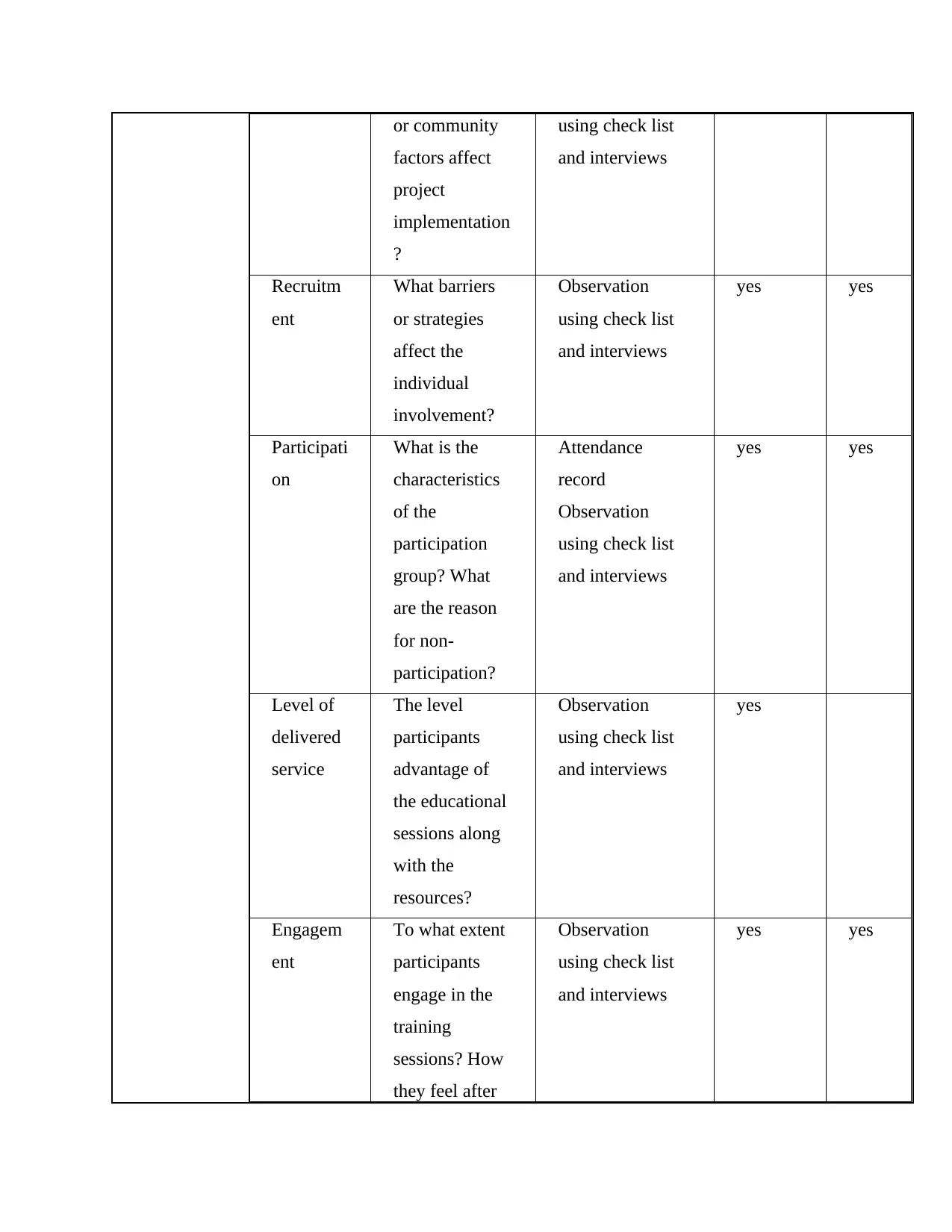
or community
factors affect
project
implementation
?
using check list
and interviews
Recruitm
ent
What barriers
or strategies
affect the
individual
involvement?
Observation
using check list
and interviews
yes yes
Participati
on
What is the
characteristics
of the
participation
group? What
are the reason
for non-
participation?
Attendance
record
Observation
using check list
and interviews
yes yes
Level of
delivered
service
The level
participants
advantage of
the educational
sessions along
with the
resources?
Observation
using check list
and interviews
yes
Engagem
ent
To what extent
participants
engage in the
training
sessions? How
they feel after
Observation
using check list
and interviews
yes yes
factors affect
project
implementation
?
using check list
and interviews
Recruitm
ent
What barriers
or strategies
affect the
individual
involvement?
Observation
using check list
and interviews
yes yes
Participati
on
What is the
characteristics
of the
participation
group? What
are the reason
for non-
participation?
Attendance
record
Observation
using check list
and interviews
yes yes
Level of
delivered
service
The level
participants
advantage of
the educational
sessions along
with the
resources?
Observation
using check list
and interviews
yes
Engagem
ent
To what extent
participants
engage in the
training
sessions? How
they feel after
Observation
using check list
and interviews
yes yes
Paraphrase This Document
Need a fresh take? Get an instant paraphrase of this document with our AI Paraphraser
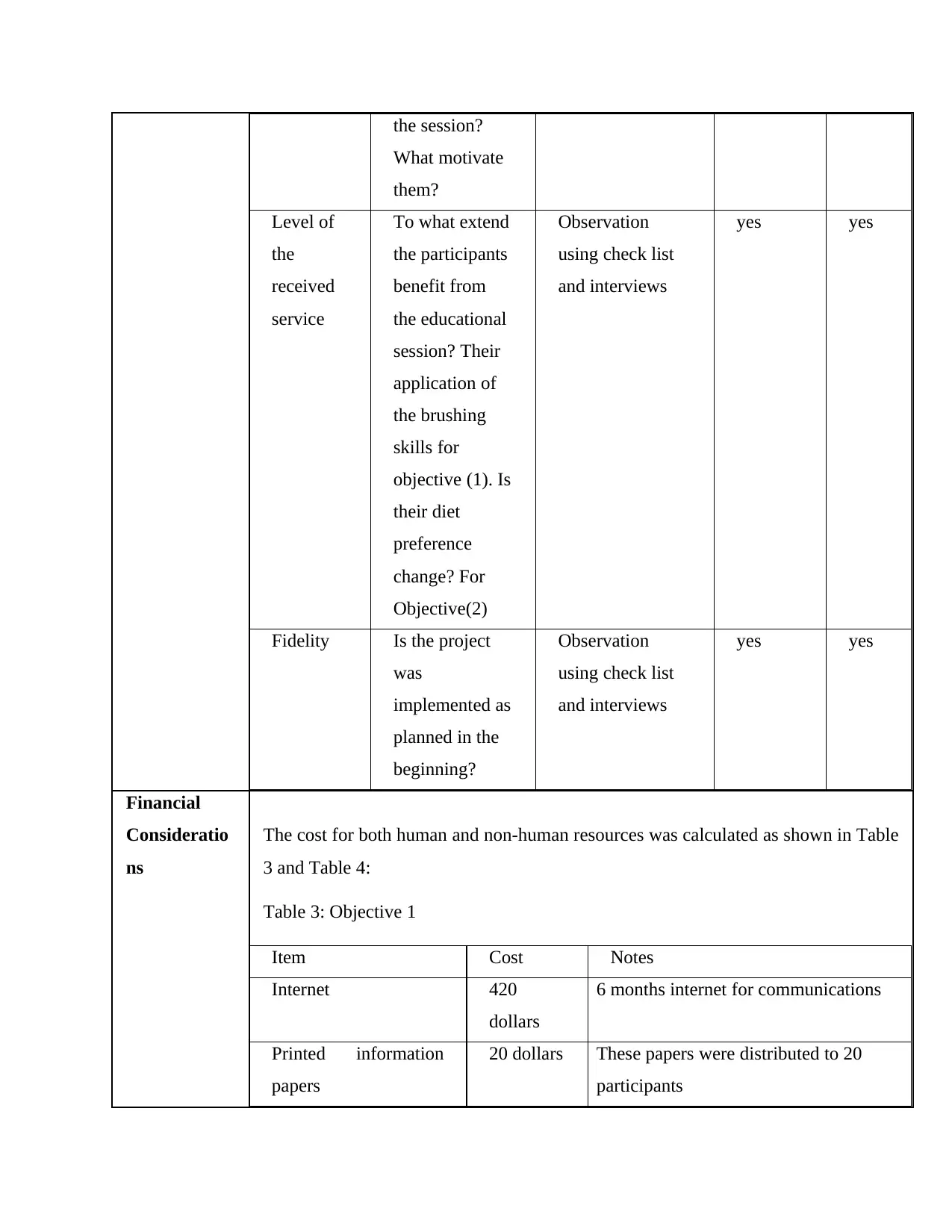
the session?
What motivate
them?
Level of
the
received
service
To what extend
the participants
benefit from
the educational
session? Their
application of
the brushing
skills for
objective (1). Is
their diet
preference
change? For
Objective(2)
Observation
using check list
and interviews
yes yes
Fidelity Is the project
was
implemented as
planned in the
beginning?
Observation
using check list
and interviews
yes yes
Financial
Consideratio
ns
The cost for both human and non-human resources was calculated as shown in Table
3 and Table 4:
Table 3: Objective 1
Item Cost Notes
Internet 420
dollars
6 months internet for communications
Printed information
papers
20 dollars These papers were distributed to 20
participants
What motivate
them?
Level of
the
received
service
To what extend
the participants
benefit from
the educational
session? Their
application of
the brushing
skills for
objective (1). Is
their diet
preference
change? For
Objective(2)
Observation
using check list
and interviews
yes yes
Fidelity Is the project
was
implemented as
planned in the
beginning?
Observation
using check list
and interviews
yes yes
Financial
Consideratio
ns
The cost for both human and non-human resources was calculated as shown in Table
3 and Table 4:
Table 3: Objective 1
Item Cost Notes
Internet 420
dollars
6 months internet for communications
Printed information
papers
20 dollars These papers were distributed to 20
participants
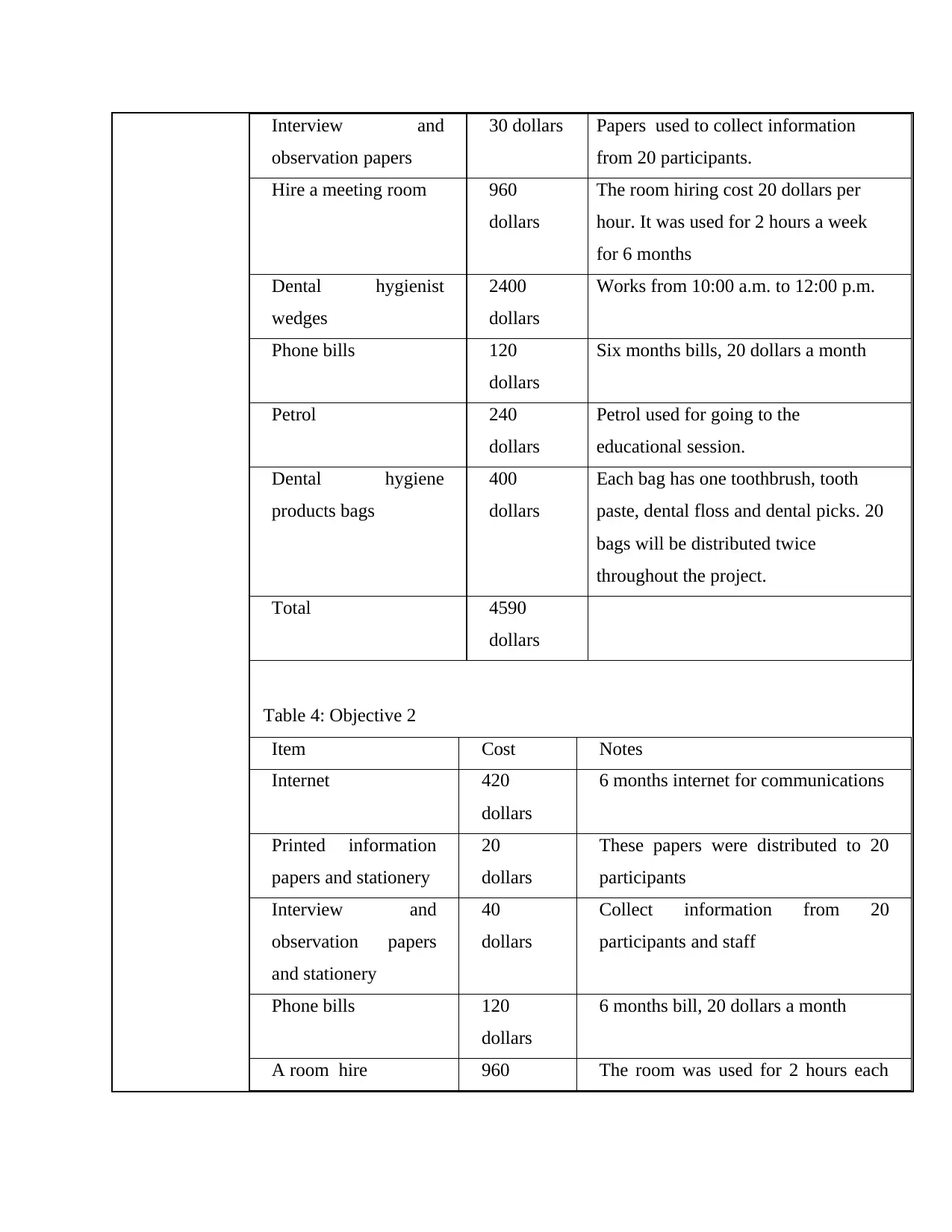
Interview and
observation papers
30 dollars Papers used to collect information
from 20 participants.
Hire a meeting room 960
dollars
The room hiring cost 20 dollars per
hour. It was used for 2 hours a week
for 6 months
Dental hygienist
wedges
2400
dollars
Works from 10:00 a.m. to 12:00 p.m.
Phone bills 120
dollars
Six months bills, 20 dollars a month
Petrol 240
dollars
Petrol used for going to the
educational session.
Dental hygiene
products bags
400
dollars
Each bag has one toothbrush, tooth
paste, dental floss and dental picks. 20
bags will be distributed twice
throughout the project.
Total 4590
dollars
Table 4: Objective 2
Item Cost Notes
Internet 420
dollars
6 months internet for communications
Printed information
papers and stationery
20
dollars
These papers were distributed to 20
participants
Interview and
observation papers
and stationery
40
dollars
Collect information from 20
participants and staff
Phone bills 120
dollars
6 months bill, 20 dollars a month
A room hire 960 The room was used for 2 hours each
observation papers
30 dollars Papers used to collect information
from 20 participants.
Hire a meeting room 960
dollars
The room hiring cost 20 dollars per
hour. It was used for 2 hours a week
for 6 months
Dental hygienist
wedges
2400
dollars
Works from 10:00 a.m. to 12:00 p.m.
Phone bills 120
dollars
Six months bills, 20 dollars a month
Petrol 240
dollars
Petrol used for going to the
educational session.
Dental hygiene
products bags
400
dollars
Each bag has one toothbrush, tooth
paste, dental floss and dental picks. 20
bags will be distributed twice
throughout the project.
Total 4590
dollars
Table 4: Objective 2
Item Cost Notes
Internet 420
dollars
6 months internet for communications
Printed information
papers and stationery
20
dollars
These papers were distributed to 20
participants
Interview and
observation papers
and stationery
40
dollars
Collect information from 20
participants and staff
Phone bills 120
dollars
6 months bill, 20 dollars a month
A room hire 960 The room was used for 2 hours each
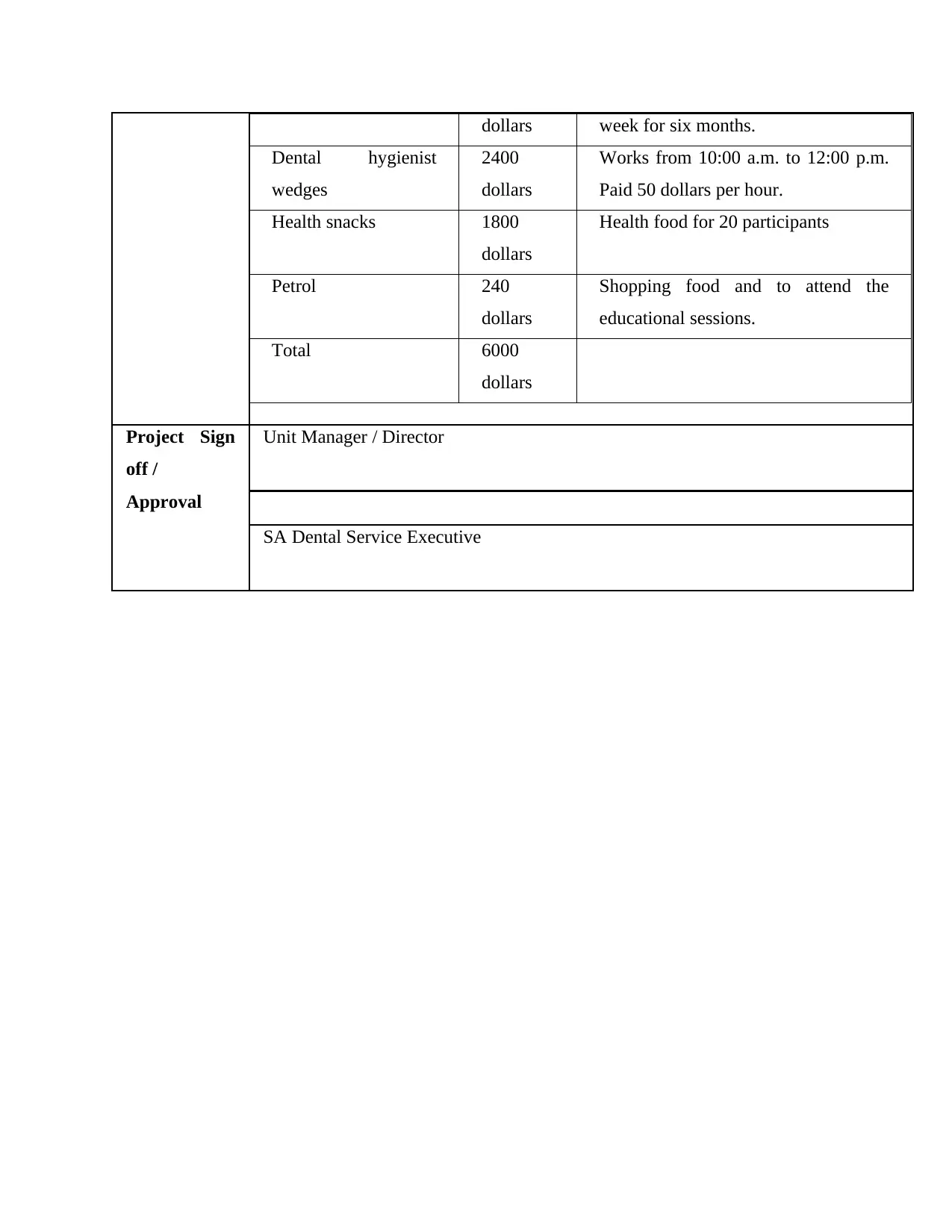
dollars week for six months.
Dental hygienist
wedges
2400
dollars
Works from 10:00 a.m. to 12:00 p.m.
Paid 50 dollars per hour.
Health snacks 1800
dollars
Health food for 20 participants
Petrol 240
dollars
Shopping food and to attend the
educational sessions.
Total 6000
dollars
Project Sign
off /
Approval
Unit Manager / Director
SA Dental Service Executive
Dental hygienist
wedges
2400
dollars
Works from 10:00 a.m. to 12:00 p.m.
Paid 50 dollars per hour.
Health snacks 1800
dollars
Health food for 20 participants
Petrol 240
dollars
Shopping food and to attend the
educational sessions.
Total 6000
dollars
Project Sign
off /
Approval
Unit Manager / Director
SA Dental Service Executive
Secure Best Marks with AI Grader
Need help grading? Try our AI Grader for instant feedback on your assignments.
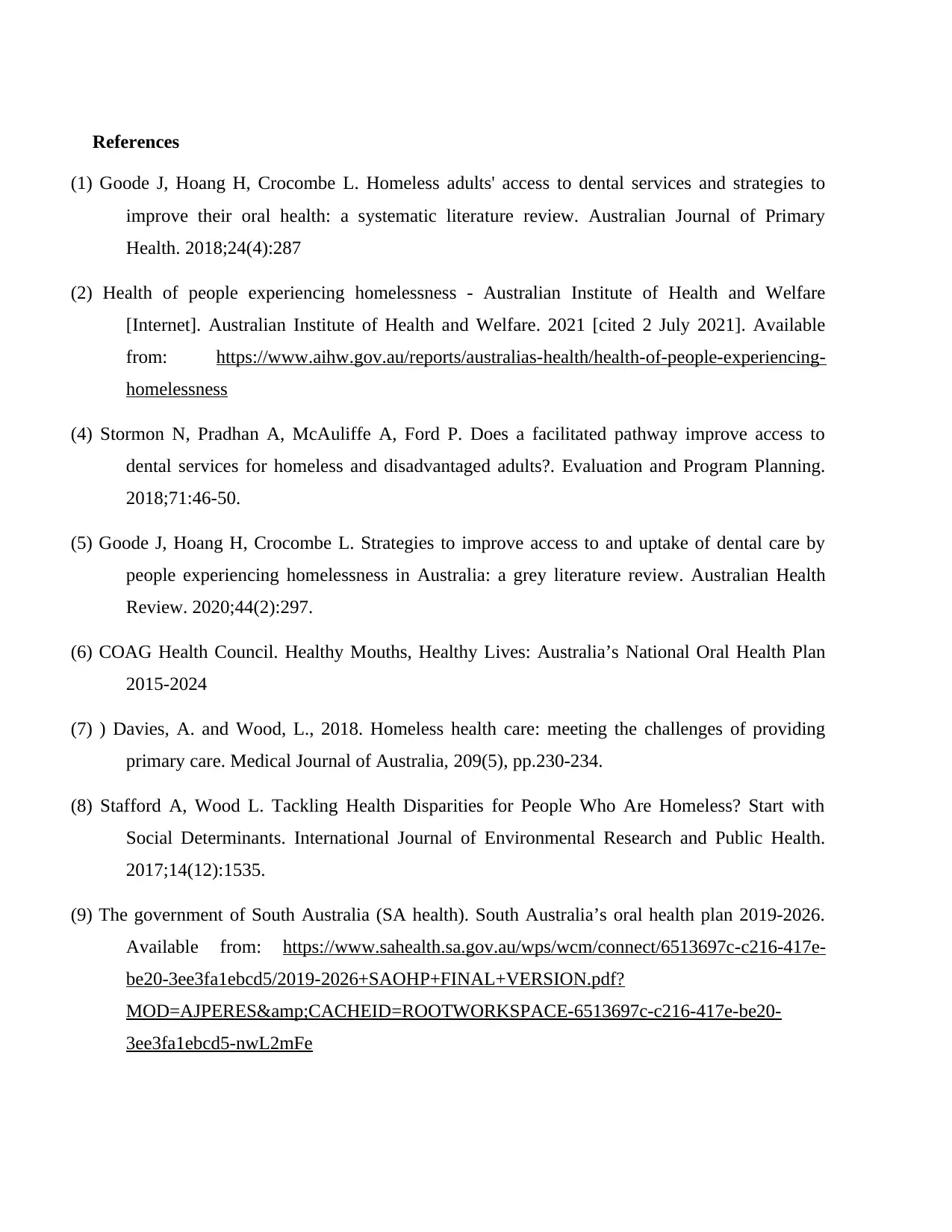
References
(1) Goode J, Hoang H, Crocombe L. Homeless adults' access to dental services and strategies to
improve their oral health: a systematic literature review. Australian Journal of Primary
Health. 2018;24(4):287
(2) Health of people experiencing homelessness - Australian Institute of Health and Welfare
[Internet]. Australian Institute of Health and Welfare. 2021 [cited 2 July 2021]. Available
from: https://www.aihw.gov.au/reports/australias-health/health-of-people-experiencing-
homelessness
(4) Stormon N, Pradhan A, McAuliffe A, Ford P. Does a facilitated pathway improve access to
dental services for homeless and disadvantaged adults?. Evaluation and Program Planning.
2018;71:46-50.
(5) Goode J, Hoang H, Crocombe L. Strategies to improve access to and uptake of dental care by
people experiencing homelessness in Australia: a grey literature review. Australian Health
Review. 2020;44(2):297.
(6) COAG Health Council. Healthy Mouths, Healthy Lives: Australia’s National Oral Health Plan
2015-2024
(7) ) Davies, A. and Wood, L., 2018. Homeless health care: meeting the challenges of providing
primary care. Medical Journal of Australia, 209(5), pp.230-234.
(8) Stafford A, Wood L. Tackling Health Disparities for People Who Are Homeless? Start with
Social Determinants. International Journal of Environmental Research and Public Health.
2017;14(12):1535.
(9) The government of South Australia (SA health). South Australia’s oral health plan 2019-2026.
Available from: https://www.sahealth.sa.gov.au/wps/wcm/connect/6513697c-c216-417e-
be20-3ee3fa1ebcd5/2019-2026+SAOHP+FINAL+VERSION.pdf?
MOD=AJPERES&CACHEID=ROOTWORKSPACE-6513697c-c216-417e-be20-
3ee3fa1ebcd5-nwL2mFe
(1) Goode J, Hoang H, Crocombe L. Homeless adults' access to dental services and strategies to
improve their oral health: a systematic literature review. Australian Journal of Primary
Health. 2018;24(4):287
(2) Health of people experiencing homelessness - Australian Institute of Health and Welfare
[Internet]. Australian Institute of Health and Welfare. 2021 [cited 2 July 2021]. Available
from: https://www.aihw.gov.au/reports/australias-health/health-of-people-experiencing-
homelessness
(4) Stormon N, Pradhan A, McAuliffe A, Ford P. Does a facilitated pathway improve access to
dental services for homeless and disadvantaged adults?. Evaluation and Program Planning.
2018;71:46-50.
(5) Goode J, Hoang H, Crocombe L. Strategies to improve access to and uptake of dental care by
people experiencing homelessness in Australia: a grey literature review. Australian Health
Review. 2020;44(2):297.
(6) COAG Health Council. Healthy Mouths, Healthy Lives: Australia’s National Oral Health Plan
2015-2024
(7) ) Davies, A. and Wood, L., 2018. Homeless health care: meeting the challenges of providing
primary care. Medical Journal of Australia, 209(5), pp.230-234.
(8) Stafford A, Wood L. Tackling Health Disparities for People Who Are Homeless? Start with
Social Determinants. International Journal of Environmental Research and Public Health.
2017;14(12):1535.
(9) The government of South Australia (SA health). South Australia’s oral health plan 2019-2026.
Available from: https://www.sahealth.sa.gov.au/wps/wcm/connect/6513697c-c216-417e-
be20-3ee3fa1ebcd5/2019-2026+SAOHP+FINAL+VERSION.pdf?
MOD=AJPERES&CACHEID=ROOTWORKSPACE-6513697c-c216-417e-be20-
3ee3fa1ebcd5-nwL2mFe
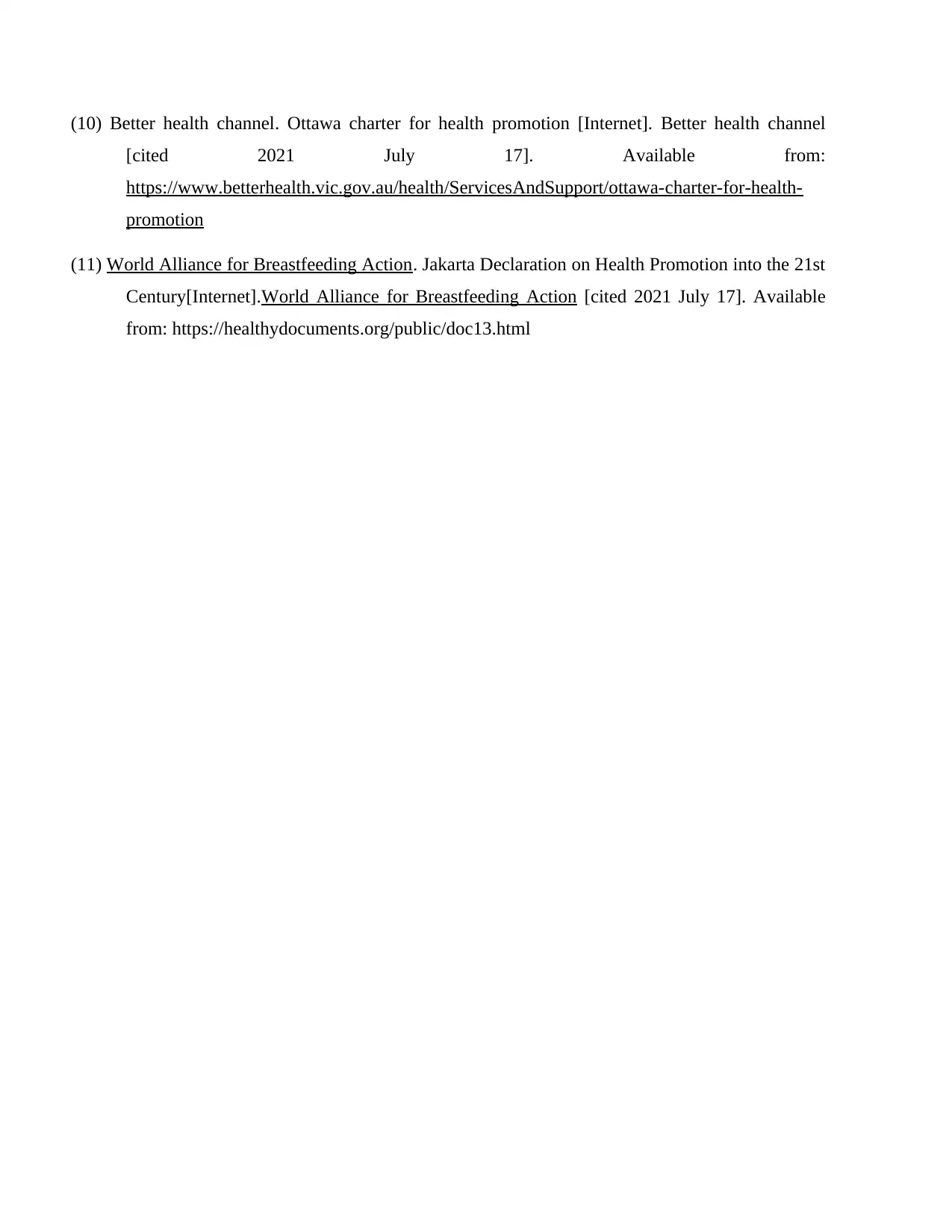
(10) Better health channel. Ottawa charter for health promotion [Internet]. Better health channel
[cited 2021 July 17]. Available from:
https://www.betterhealth.vic.gov.au/health/ServicesAndSupport/ottawa-charter-for-health-
promotion
(11) World Alliance for Breastfeeding Action. Jakarta Declaration on Health Promotion into the 21st
Century[Internet].World Alliance for Breastfeeding Action [cited 2021 July 17]. Available
from: https://healthydocuments.org/public/doc13.html
[cited 2021 July 17]. Available from:
https://www.betterhealth.vic.gov.au/health/ServicesAndSupport/ottawa-charter-for-health-
promotion
(11) World Alliance for Breastfeeding Action. Jakarta Declaration on Health Promotion into the 21st
Century[Internet].World Alliance for Breastfeeding Action [cited 2021 July 17]. Available
from: https://healthydocuments.org/public/doc13.html
1 out of 12
Related Documents
Your All-in-One AI-Powered Toolkit for Academic Success.
+13062052269
info@desklib.com
Available 24*7 on WhatsApp / Email
![[object Object]](/_next/static/media/star-bottom.7253800d.svg)
Unlock your academic potential
© 2024 | Zucol Services PVT LTD | All rights reserved.



